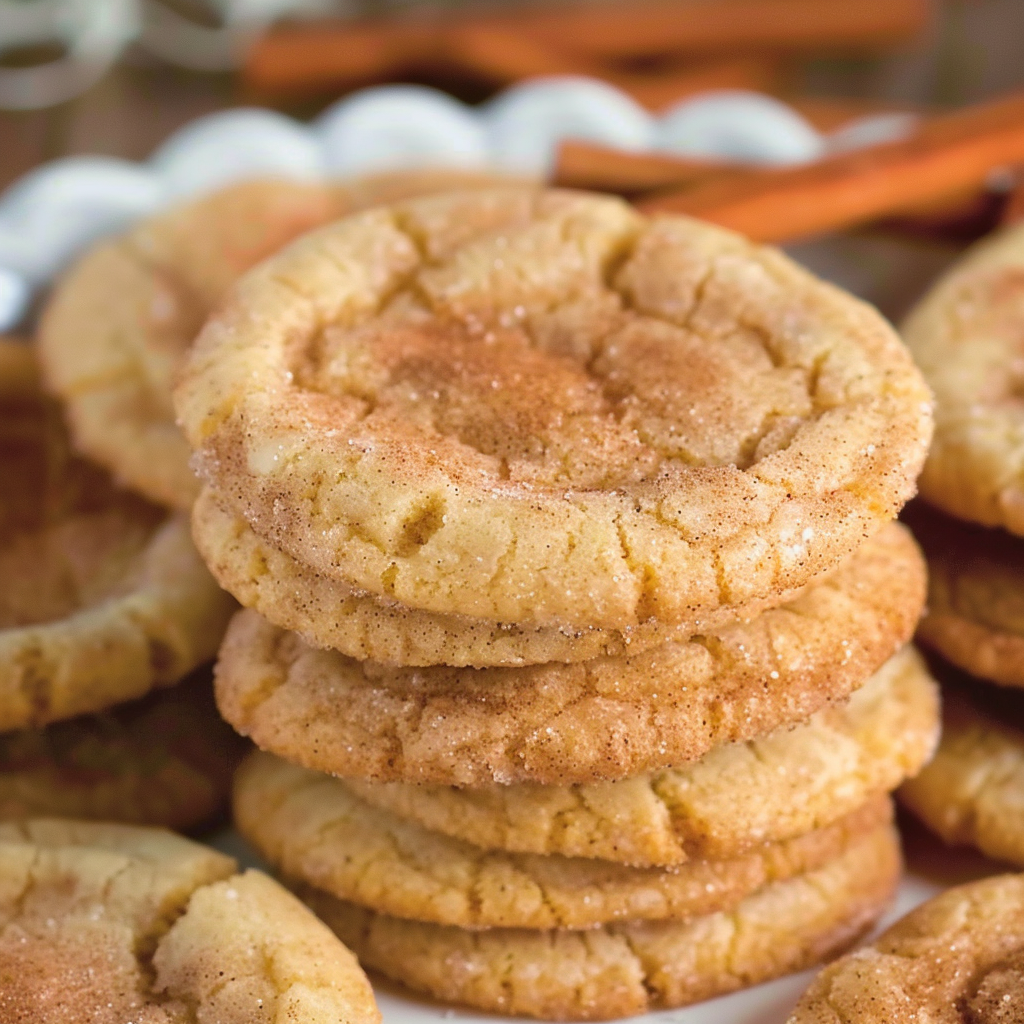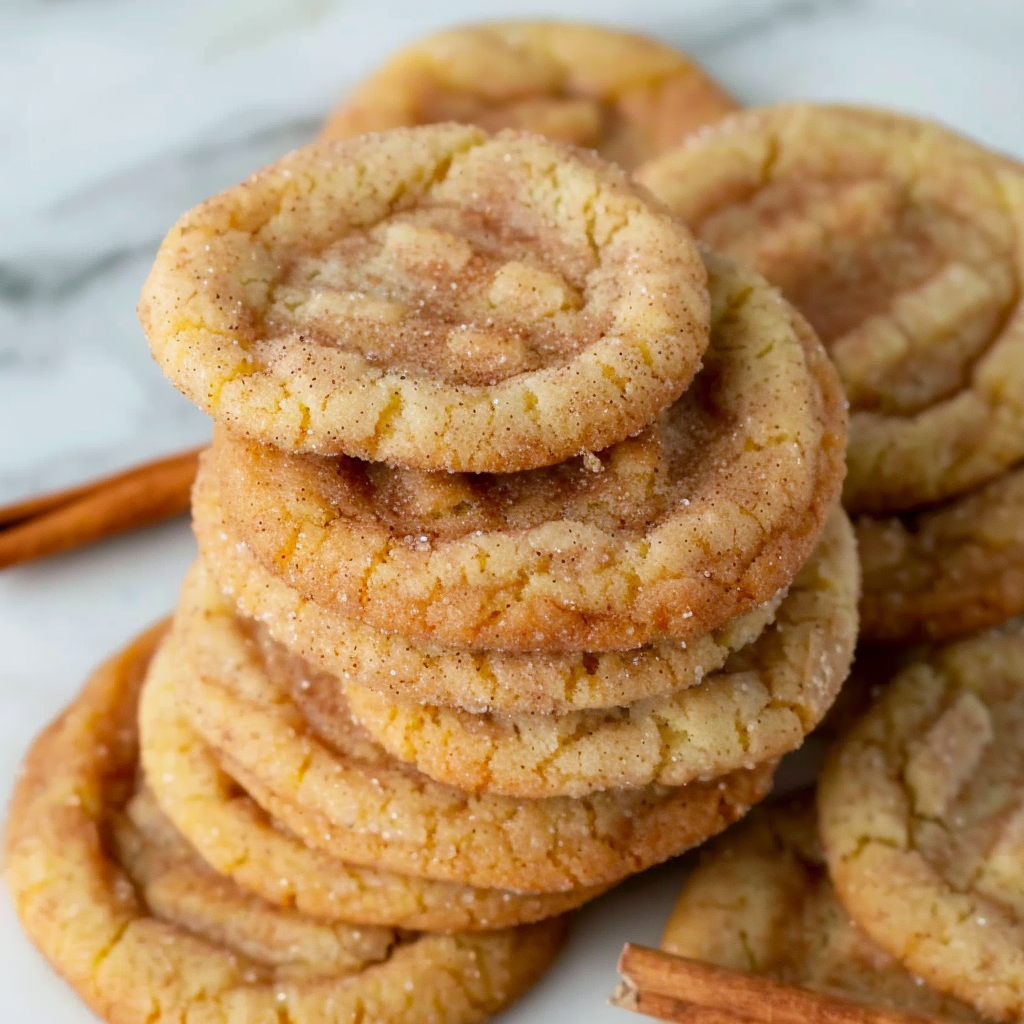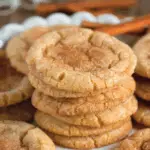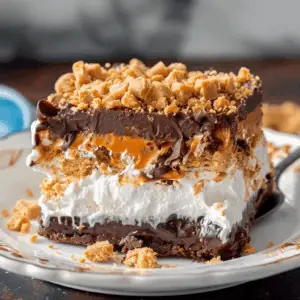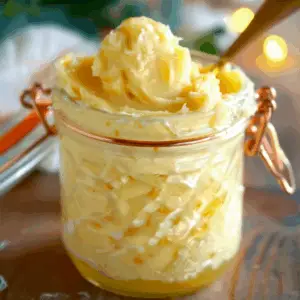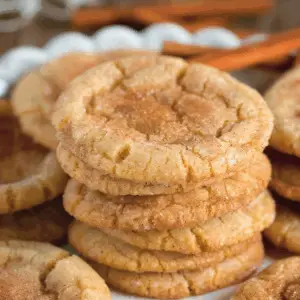A New Take on a Classic Favorite
Few cookies evoke the same nostalgic comfort as snickerdoodle cookies. With their pillowy centers, crisp golden edges, and signature cinnamon-sugar coating, snickerdoodles are a beloved treat passed down through generations. But even the most classic recipe can be elevated, and that’s where brown butter comes in—a simple yet transformative twist that intensifies the flavor, giving the cookie a richer, nuttier depth.
The appeal of this upgraded version lies in the contrast between the toasty brown butter and the sweet spice of cinnamon. This recipe delivers the same familiar chew and soft interior of a traditional sugar cookie, but with a deep, caramel-like complexity that makes it stand out. Whether you’re baking for a holiday tray, a school fundraiser, or simply craving a cozy dessert, brown butter snickerdoodles will exceed expectations every time.
The snickerdoodle cookie, believed to have originated in 19th-century New England, has long been a staple of American baking traditions. Its simplicity and distinctive flavor have made it a favorite across decades. Unlike typical sugar cookies, snickerdoodles are defined by the inclusion of cream of tartar, which gives them a slightly tangy bite and chewy texture. You can learn more about the history of snickerdoodles to see how they’ve evolved over time.
What makes this particular version stand out is the use of beurre noisette—more commonly known as brown butter. This browned version of butter introduces a rich nuttiness that adds gourmet complexity to an otherwise simple cookie. Incorporating brown butter into classic recipes has become a modern baking trend, giving familiar desserts new life with little added effort.
In this guide, you’ll find an easy, foolproof recipe that shows how to make brown butter snickerdoodle cookies at home with ingredients you likely already have. From the science of brown butter to the perfect cinnamon sugar ratio, we’ll walk through everything you need to create the ultimate twist on a timeless classic. Along the way, we’ll also explore ways to customize your cookies, store them properly, and answer the most common questions people ask about this beloved dessert.
Let’s dive into the story, flavor, and process behind making the best snickerdoodle cookies—better than ever with the warm, aromatic boost of brown butter.
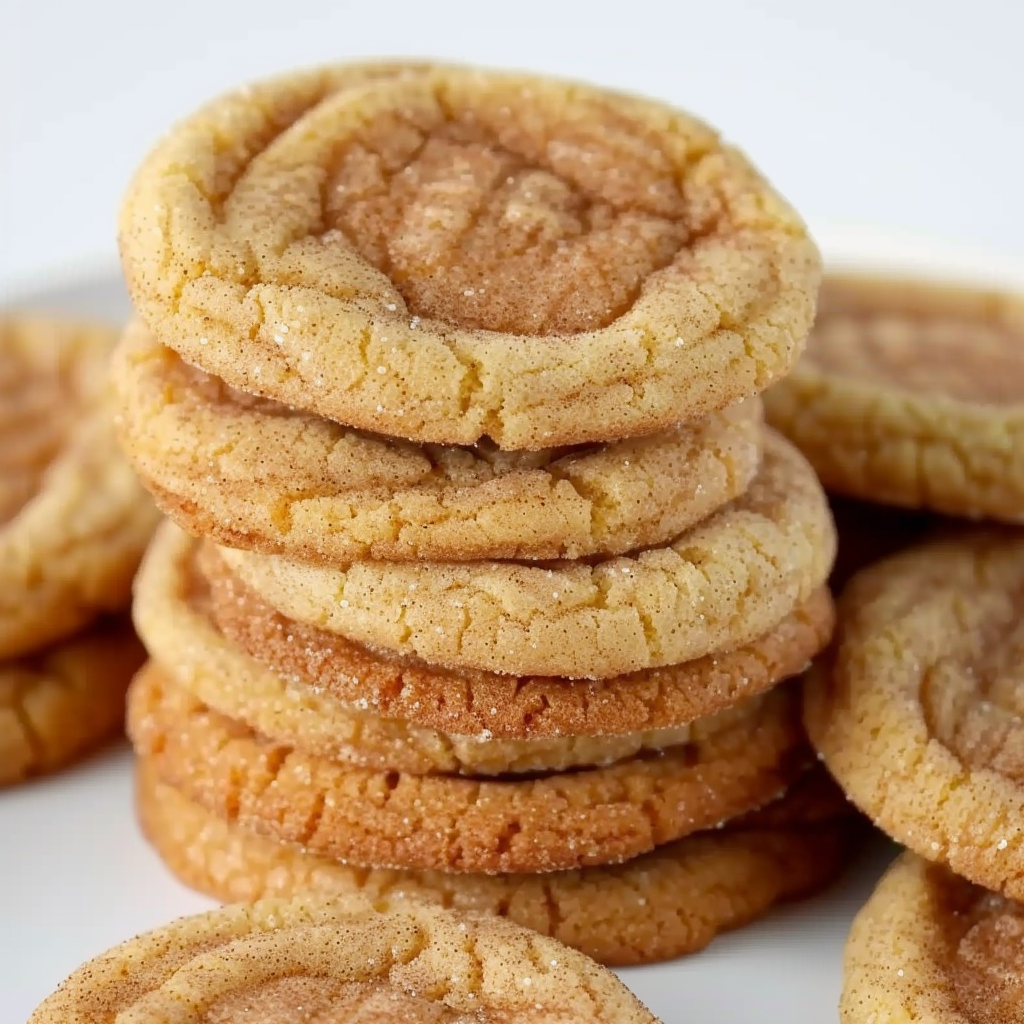
What Is a Snickerdoodle Cookie?
Snickerdoodle cookies are often mistaken for simple sugar cookies, but they’re far more than that. While both cookies share a base of flour, sugar, butter, and eggs, the defining elements of snickerdoodles are cream of tartar and the cinnamon sugar coating. These two ingredients give the cookie its signature tangy flavor and crackled appearance, making it instantly recognizable and distinct from other cookies.
Unlike sugar cookies that are often rolled flat and cut into shapes, snickerdoodles are usually hand-rolled into balls and baked without flattening. This technique results in a pillowy center and crisp edges—an irresistible contrast in textures. Their hallmark crackle comes from the reaction between baking soda and cream of tartar, a combination that not only leavens the dough but also provides the slightly sour note that fans love. Curious about the science? You can read more about cream of tartar and its role in baking to understand its effect on cookie texture.
Though the exact origin of the snickerdoodle is debated, many culinary historians believe it has roots in German or Dutch baking traditions, brought to America in the 1800s. Over the decades, it’s earned a strong place in American kitchens, often appearing in holiday spreads, potlucks, and bake sales. Their popularity also grew thanks to their inclusion in vintage cookie cookbooks and homemaker magazines.
The most essential elements that define a true snickerdoodle include:
-
Cream of tartar for that tangy chew
-
A soft, slightly underbaked center
-
Rolled in a cinnamon-sugar blend for warmth and spice
-
Baked until just golden around the edges, but still light in the center
Snickerdoodles offer a subtle but satisfying flavor experience. They’re not overly sweet or overloaded with ingredients—they shine through simplicity. But this simplicity also makes them the perfect canvas for modern twists, like adding brown butter or stuffing them with rich fillings. By exploring variations, we can both preserve the traditional charm and enhance the flavor in new ways.
For anyone building a holiday cookie platter or a versatile dessert board, snickerdoodles are essential. You can find creative cookie platter ideas on Pinterest for inspiration. Whether you’re serving them warm with coffee or packing them into a gift box, these cookies bring a nostalgic warmth that’s hard to match.
Why Brown Butter Elevates This Recipe
The secret to making these snickerdoodle cookies truly unforgettable is the addition of brown butter. This single ingredient transforms the flavor profile, adding deep, nutty notes that enhance the cookie’s classic warmth. While traditional snickerdoodles rely on softened butter for richness, browning the butter before mixing it into the dough brings a gourmet twist that makes the cookies more complex, aromatic, and indulgent.
Brown butter, also known by its French term beurre noisette, is made by slowly cooking unsalted butter until the milk solids caramelize. The process produces a golden-brown liquid that smells nutty and toasty—like hazelnuts, hence the name. In baking, this intensifies flavor without needing to add more spices or sugar. When used in snickerdoodle cookie dough, brown butter cuts through the sweetness and highlights the cinnamon, giving the cookie a caramel-like undertone.
Here’s how brown butter changes the game:
-
It brings out toasty, roasted flavors that contrast beautifully with the sweet cinnamon-sugar coating.
-
It enhances the aroma of the cookies, giving them a rich, bakery-style scent.
-
It deepens the color of the dough, resulting in a slightly more golden cookie that still maintains its classic texture.
-
It reduces the water content slightly, leading to a chewier center and more crisp edges.
When preparing brown butter for your cookies, it’s important to let it cool slightly before mixing it into the dough. If it’s too hot, it can scramble the eggs or melt the sugar too quickly, altering the consistency. For a step-by-step method, you can refer to guides on how to make perfect brown butter or check out cookie bar recipes on Pinterest that use the same technique.
Adding brown butter to a cookie recipe is a minimalist way to elevate flavor without changing the familiar comfort of a classic snickerdoodle. It’s an ideal upgrade that requires no fancy ingredients—just a little extra time and attention to detail.
This flavor boost also pairs beautifully with add-ins like flaky sea salt or even stuffed centers, which we’ll explore later in the variations section. But even on its own, the brown butter version offers a richer experience for anyone who appreciates classic desserts with a modern, flavorful edge.
Essential Ingredients Breakdown
Creating the perfect brown butter snickerdoodle starts with understanding each ingredient’s purpose. Every component plays a critical role in delivering the cookie’s signature texture, taste, and structure. This breakdown explains why each ingredient is used and how it contributes to the final result.
Dry Ingredients
-
All-Purpose Flour (2 ¾ cups)
Provides the structural foundation of the cookie. It creates the chewy bite and helps the cookies hold their shape. The protein content in all-purpose flour strikes a balance between softness and strength, making it ideal for snickerdoodles. -
Cream of Tartar (2 tsp)
This key ingredient sets snickerdoodles apart from sugar cookies. It gives the cookie its signature tang and also prevents the sugar from crystallizing, which contributes to a softer texture. Learn more about cream of tartar and its chemical properties in baking. -
Baking Soda (1 tsp)
Works with the cream of tartar as a leavening agent. It helps the dough rise and creates that classic crinkle on top. Curious about the science behind it? Check out baking soda’s role in baking chemistry. -
Salt (½ tsp)
Enhances flavor and balances sweetness. Salt also strengthens gluten formation, contributing to cookie structure.
Wet Ingredients
-
Unsalted Butter (1 cup, browned)
The star of the recipe. Browning the butter transforms it into a rich, nutty liquid fat that adds deep flavor and a hint of caramel. Once browned, let it cool slightly to avoid melting the sugar too quickly when mixing. Refer to this guide to brown butter for best practices. -
Granulated Sugar (1 ½ cups in dough + ¼ cup for coating)
Sweetens the cookie and contributes to its crispy edges. Granulated sugar also helps with spreading. The extra ¼ cup is combined with cinnamon for the coating. -
Eggs (2 large)
Act as binders and add moisture. They give the cookies their tender, chewy interior. Eggs also help emulsify the fats and liquids in the dough. -
Vanilla Extract (1 tsp)
Adds a warm, aromatic background that enhances the cinnamon and brown butter. Even a small amount of high-quality vanilla can significantly deepen flavor.
Cinnamon Sugar Coating
-
Ground Cinnamon (1 tbsp)
Provides the signature warm spice. Cinnamon not only defines the flavor of a snickerdoodle but also offers a fragrant, cozy aroma. -
Granulated Sugar (¼ cup)
Used in combination with cinnamon for the coating. This layer caramelizes slightly in the oven, forming the iconic crackled top.
Together, these ingredients create a perfect harmony of flavor and texture—chewy, soft in the middle, crisp on the edges, and fragrant with warm spice. You can find beautiful holiday cookie recipes featuring these ingredients on Pinterest if you’re planning a seasonal bake.
By mastering the purpose behind each element, you can begin to experiment confidently—adjusting sweetness, swapping flours, or adding mix-ins—without losing the essence of what makes a snickerdoodle truly special.
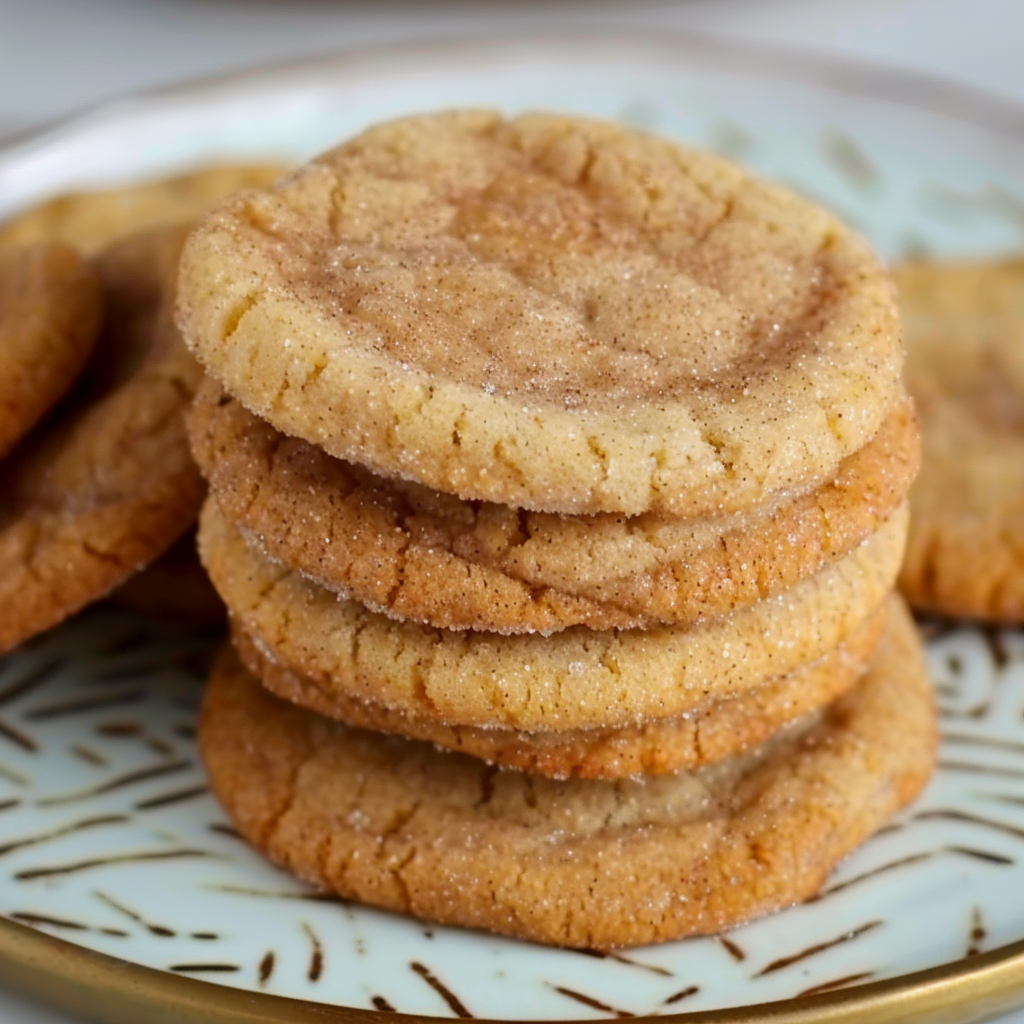
Step-by-Step Instructions With Pro Tips
Making brown butter snickerdoodle cookies is simple, but a few strategic steps will ensure your cookies turn out perfectly every time. Follow this process carefully, and don’t skip the pro tips—they’re key to achieving the ideal texture and flavor.
1. Preheat and Prep
Preheat your oven to 375°F (190°C). Line two baking sheets with parchment paper or silicone baking mats. This prevents sticking and promotes even browning.
2. Brown the Butter
In a saucepan, melt 1 cup of unsalted butter over medium heat. Stir constantly until the butter foams, then turns golden with brown flecks forming at the bottom. It should smell nutty and rich. Once browned, immediately transfer it to a heatproof bowl to cool slightly for 10–15 minutes. For a step-by-step guide, reference beurre noisette for best practices.
3. Mix the Dry Ingredients
In a medium bowl, whisk together:
-
2 ¾ cups all-purpose flour
-
2 tsp cream of tartar
-
1 tsp baking soda
-
½ tsp salt
This mixture forms the base of the dough. Learn more about flour types to experiment with variations like whole wheat or gluten-free options later.
4. Combine the Wet Ingredients
In a large bowl, beat together the browned butter and 1 ½ cups granulated sugar until combined. Add the eggs one at a time, beating well after each. Mix in 1 tsp vanilla extract.
Pro Tip: Make sure the brown butter is warm but not hot, or it will affect the eggs and sugar consistency.
5. Add the Dry Ingredients to the Wet
Gradually stir the flour mixture into the wet ingredients. Use a spatula or mixer on low speed to avoid overmixing. The dough will be thick and fragrant.
Pro Tip: For extra chewy cookies, chill the dough for 30 minutes before baking.
6. Prepare Cinnamon Sugar Coating
In a small bowl, mix:
-
¼ cup granulated sugar
-
1 tbsp ground cinnamon
This is the classic snickerdoodle finish that gives the cookies their signature look and flavor.
7. Form the Cookies
Scoop tablespoon-sized portions of dough and roll them into balls. Then roll each dough ball in the cinnamon sugar mixture until completely coated. Place on prepared baking sheets, spacing about 2 inches apart.
Pro Tip: Use a cookie scoop for uniform size and even baking.
8. Bake and Cool
Bake in preheated oven for 8–10 minutes. The edges should be set, but the centers should look slightly underbaked. Don’t overbake.
Remove from the oven and let them cool on the baking sheet for 2–3 minutes before transferring to a wire rack. This helps the cookies firm up without becoming dry.
Pro Tip: Slight underbaking ensures soft, chewy centers—classic for snickerdoodles.
Looking for more inspiration? Browse holiday cookie ideas or cookie gift box displays on Pinterest to see how others present and serve their snickerdoodles.
Snickerdoodle Variations You’ll Love
Once you’ve mastered the base recipe, there are endless ways to make it your own. These snickerdoodle variations build on the brown butter base and bring fresh flavor combinations and textures to the classic cookie.
1. Brown Butter + Sea Salt
After baking, sprinkle warm cookies with a pinch of flaky sea salt. The contrast of salty and sweet intensifies the cookie’s richness.
2. Stuffed Snickerdoodles
Before baking, flatten dough balls slightly and place a teaspoon of caramel, chocolate spread, or Nutella in the center. Fold the dough around the filling and seal. Bake as directed.
3. Pumpkin Snickerdoodles
Replace ¼ cup of the butter with pumpkin purée. Add ½ tsp pumpkin pie spice for a seasonal twist. Great for autumn cookie platters.
4. Gluten-Free Option
Swap out all-purpose flour with a 1:1 gluten-free baking blend. Ensure it contains xanthan gum for binding. These maintain a similar texture and flavor.
5. Vegan Snickerdoodles
Replace eggs with flax eggs (1 tbsp flaxseed + 3 tbsp water per egg) and use plant-based butter. Brown the vegan butter carefully to retain flavor.
These variations allow you to adapt the recipe for different occasions or dietary needs while keeping the core elements of a snickerdoodle intact. You can find inspiration for creative variations on Pinterest with seasonal twists and presentation ideas.
Storing & Freezing Snickerdoodles the Right Way
Proper storage ensures your snickerdoodle cookies stay soft, chewy, and delicious for days—or even weeks if frozen correctly.
Counter Storage
-
Store cookies in an airtight container at room temperature.
-
Place a slice of bread in the container to help retain moisture.
-
Cookies stay fresh for up to 5 days.
Freezing Dough
-
Roll dough into balls and coat in cinnamon sugar.
-
Place on a tray and freeze for 1 hour, then transfer to a freezer-safe bag.
-
Bake straight from frozen, adding 1–2 minutes to baking time.
Freezing Baked Cookies
-
Let cookies cool completely.
-
Store in layers between wax paper in an airtight container.
-
Freeze for up to 2 months.
Reheating Tip
-
Warm baked cookies in the microwave for 10–15 seconds to restore softness.
Need more ideas for storing cookies or assembling cookie gift boxes? Find creative packaging ideas for holiday gifting.
Perfect Occasions for Snickerdoodles
These cookies are versatile and well-suited for a wide range of events. Their familiar flavor and charming appearance make them an easy crowd favorite.
1. Holiday Platters
Snickerdoodles pair well with chocolate, gingerbread, and peppermint cookies on festive trays.
2. Bake Sales
Affordable ingredients and wide appeal make them perfect for school or community fundraisers.
3. Potlucks & Parties
Soft cookies that stay fresh for days are great for sharing and travel well.
4. Cookie Gift Boxes
Include them with a mix of cookies in a curated box. Check out cookie platter ideas for presentation tips.
Whether it’s a casual get-together or a formal event, snickerdoodles feel both comforting and special.
FAQs (People Also Ask)
What makes a snickerdoodle different from a sugar cookie?
Snickerdoodles contain cream of tartar, giving them a tangy flavor and chewy texture. They’re also rolled in cinnamon sugar, which sugar cookies are not.
Do you have to use cream of tartar?
Yes, if you want a true snickerdoodle. Cream of tartar contributes to the texture and flavor. Without it, the result is closer to a basic sugar cookie.
Can I make snickerdoodles without brown butter?
Absolutely. You can use regular softened butter. However, browning the butter adds a nutty richness that elevates the cookie’s flavor.
How do I know when snickerdoodles are done baking?
The edges should be set, and the center should look slightly underbaked. This ensures a soft, chewy middle. Overbaking will lead to dryness.
Why are my snickerdoodles hard or flat?
This could be due to overbaking, not using cream of tartar, or not allowing the brown butter to cool before mixing. Chilling the dough also helps control spreading.
Snickerdoodle Cookies The Classic Sugar Cookie Made Better With Brown Butter
These brown butter snickerdoodle cookies are a warm, cozy upgrade to the classic sugar cookie. Rich with nutty, toasty notes from browned butter and finished with a fragrant cinnamon sugar coating, they deliver a pillowy-soft center and delicately crisp edges. This easy-to-follow recipe is perfect for holiday baking, cookie exchanges, or anytime you’re craving something nostalgic with a modern twist.
- Author: Clara
Ingredients
For the dough:
- 2 ¾ cups all-purpose flour
- 2 teaspoons cream of tartar
- 1 teaspoon baking soda
- ½ teaspoon salt
- 1 cup unsalted butter, softened
- 1 ½ cups granulated sugar
- 2 large eggs
- 1 teaspoon vanilla extract
For the cinnamon sugar coating:
- ¼ cup granulated sugar
- 1 tablespoon ground cinnamon
Instructions
- Preheat your oven to 375°F (190°C). Line baking sheets with parchment paper.
- In a medium bowl, whisk together flour, cream of tartar, baking soda, and salt. Set aside.
- In a large bowl, beat the softened butter and 1 ½ cups sugar until light and fluffy.
- Add the eggs one at a time, beating well after each. Mix in the vanilla extract.
- Gradually add the dry ingredients to the wet mixture, mixing until just combined.
- In a small bowl, mix together the ¼ cup sugar and cinnamon for coating.
- Scoop tablespoon-sized amounts of dough and roll into balls. Roll each ball in the cinnamon sugar mixture until fully coated.
- Place the coated dough balls onto the prepared baking sheets, spacing them about 2 inches apart.
- Bake for 8–10 minutes, or until the edges are set and the centers look slightly underbaked.
- Let the cookies cool on the baking sheet for a few minutes before transferring to a wire rack to cool completely.
Notes
-
Make ahead: The dough can be made up to 48 hours in advance and refrigerated. Let it soften slightly before scooping.
-
Browning butter: Keep a close eye while browning; it can burn quickly once the milk solids sink and begin to toast.
-
No mixer needed: This recipe can be mixed by hand once the butter is browned and cooled.
-
For thicker cookies: Chill the dough for 30 minutes to prevent excess spreading.
-
Spice it up: Add a pinch of nutmeg or cardamom to the cinnamon sugar for an extra kick.
-
Gifting tip: Pair snickerdoodles with chocolate crinkle cookies and gingerbread in a festive tin or cookie gift box.
